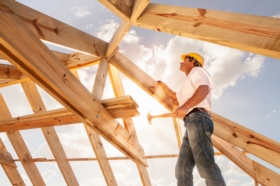




In construction, the trend is slowly moving toward green homes. Finished the traditional houses in concrete or stone, performing but harmful materials. What people want is to go back to basics and build local and natural. Thanks to biosourced materials (or ecomaterials), it is quite possible. These materials are growing in our regions because of their many benefits.
Are you thinking seriously about buying land to build your house? Still wondering about the choice of materials? Have you ever thought about biobased materials? Sustainable development is at the heart of the concerns in the construction sector. These materials have some success with new homeowners seeking more local and natural housing and are slowly but surely starting to appear as an interesting ecological and economical alternative to more traditional materials from the oil industry.
The construction sector has a heavy environmental impact. Materials therefore have a major role in reducing this impact. Opting for bio-sourced materials therefore appears to be necessary in this desire to respect the environment.
Bio-based materials or eco-materials (sometimes referred to as green materials) are often referred to as healthy building materials because they do not have a negative impact on health and are derived from sustainably renewable and truly renewable resources, with no impact on others. natural environments or species.
To be considered as biobased, the material must consist at least in part of material of biological origin (plant or animal). In addition to meeting the usual technical criteria (performance, sustainability, safety, etc.), they also meet socio-environmental criteria throughout their entire life cycle.
In short, local materials, renewable and biodegradable and implemented to be disassembled when needed.
This type of material also has many advantages, some of which are sometimes surprising but crucial. Due to their local nature, these materials create jobs nearby (without intermediaries), with a short supply distance (products are often available in the region) and guarantee a better environment for workers during the construction phase. (better comfort and quality of the air, acoustic and visual qualities).
From an environmental point of view, biobased materials have low environmental impacts, unlike other materials such as concrete. They reduce the ecological footprint of the habitat as well as greenhouse gas emissions.
Some of these bio-sourced materials have been used for millennia, even though they have long been set aside for other materials and still remain a minority today. Some, however, take the step and opt for this return to fundamentals. Faced with ever higher demands for energy efficiency, these materials seem the most suitable solution.
Several types of biobased materials exist: those derived from forestry such as wood and its derivatives, the agricultural sector such as hemp, straw, flax or sheep's wool, and those from recycling such as recycled paper and cardboard.
The applications are not lacking, these materials can be easily used as structural element, insulation, flooring, concrete, panels or paints / varnishes. However, they must be integrated at the design stage of the project to limit unforeseen and additional costs.
Some varieties of wood such as cedar or cypress are reputed to be rot-proof and durable. If wood has been used in green building for a very long time, it almost disappeared during mass construction.
Its advantages are numerous. In addition to its aesthetics, the wood offers excellent thermal insulation and absorbs moisture from the air. In the form of panels, it is also very resistant to humidity, is vapor permeable and is effective against thermal bridges. As for cork, it also resists parasites and guarantees stability over time, it does not rot.
Among the ecomaterials intended for insulation, hemp figures prominently. The woody heart of this plant combines strength and elasticity. Mixed with plaster and water, it becomes one of the best natural and durable building materials with effective thermal insulating properties. Hemp is available in many forms, everything can be used.
Fiber or hemp wool can isolate lost or developed attics. In roll, hemp perfectly isolates load-bearing walls and supporting structures. Even seeds and dust can be used for the manufacture of wood treatment impregnation oil and dry toilet absorbent, respectively.
This mineral and natural binder has many qualities. It kills bacteria, breathes and is impervious to runoff water. Associated with hemp, it gives birth to hemp concrete with highly sought performances.
Envelopes of cereals (rice, spelled, buckwheat, barley, etc.) have proven their effectiveness as natural insulators. These recycled "waste" ensure thermal and sound comfort. The bales can be used inter alia for under-roof insulation, insulation of floors or attics lost but also as insulation for walls and partitions, roofs, etc.
Straw has found new utility in the construction sector. From cereals or lavender, the straws are used as insulation for the walls. They are dried, screened, dusted and bagged stacked in the frame of the wall on which the roof and the floors rest.
Long reserved for the coating of ecological houses, the earth is making a big comeback in construction. A natural, local, sustainable and economical material that meets the needs of the environment, despite the psychological and regulatory obstacles. Land also requires little processing and has the advantages of improving the quality of indoor air and regulating the temperature.
It is quite possible to build your house with materials found at the coast. Sand, particularly resistant, can indeed be used as walls for your walls offering you high thermal capacities. Once dried, the algae can serve as ecological insulation. Just attach bags of canvas algae to the supporting structure of your walls.
Sheep wool is particularly effective against sound bridges and guarantees stability over time. In general, vegetable and animal wools are less toxic to laying and use than mineral wools.
Perennial reed species of Chinese origin, Miscanthus is used in particular for combustion for heating or processing. In addition to not requiring pesticides or fertilizers, Miscanthus stores carbon which allows a very good thermal resistance and excellent sound insulation. Very bulky, it is difficult to transport.
To verify that the products comply with bio ecology or respect the environment, labels are affixed to them, such as the VIBE label or the NaturePlus label (an international label that specifies the healthy and ecological nature of construction).
Although biobased materials are said to be natural and have no effect on the environment and health, they undergo a process of transformation during manufacture like other materials. Additives (some non-biosourced) are added in varying proportions. These ecomaterials are therefore not 100% natural but some of them are very little processed.
Contrary to popular belief, resorting to ecomaterials is not necessarily more expensive for your portfolio. Since these materials are mostly local and from short circuits, and thanks to their remarkable energy performance, they can ultimately cost you less than traditional materials. All of course depends on the desired materials and their availability. However, the difference could come from the additional costs of adding options that were not reflected at the outset of the project.
Some brakes prevent the biobased to progress fully. The transformation of biosourced materials is one of these brakes. The transformation tools require significant investments for producers. Regulations and standards are also among these obstacles, particularly in the area of building recognition and insurability. Methods and procedures for evaluating and validating the construction system seem difficult to define. All the technical brakes require that the actors (project managers and building owners) are trained.
But levers allow the progress of bio-based, such as the recovery of organic waste. European regulations provide for sorting and recycling at source of biowaste as well as separate collection of other waste. And this, before December 31, 2023. The challenge here is to get a compost that will return to the soil to allow the organic matter to return to the ground.
Several incentives also exist to encourage individuals to choose sustainable construction and biobased and more environmentally friendly materials.